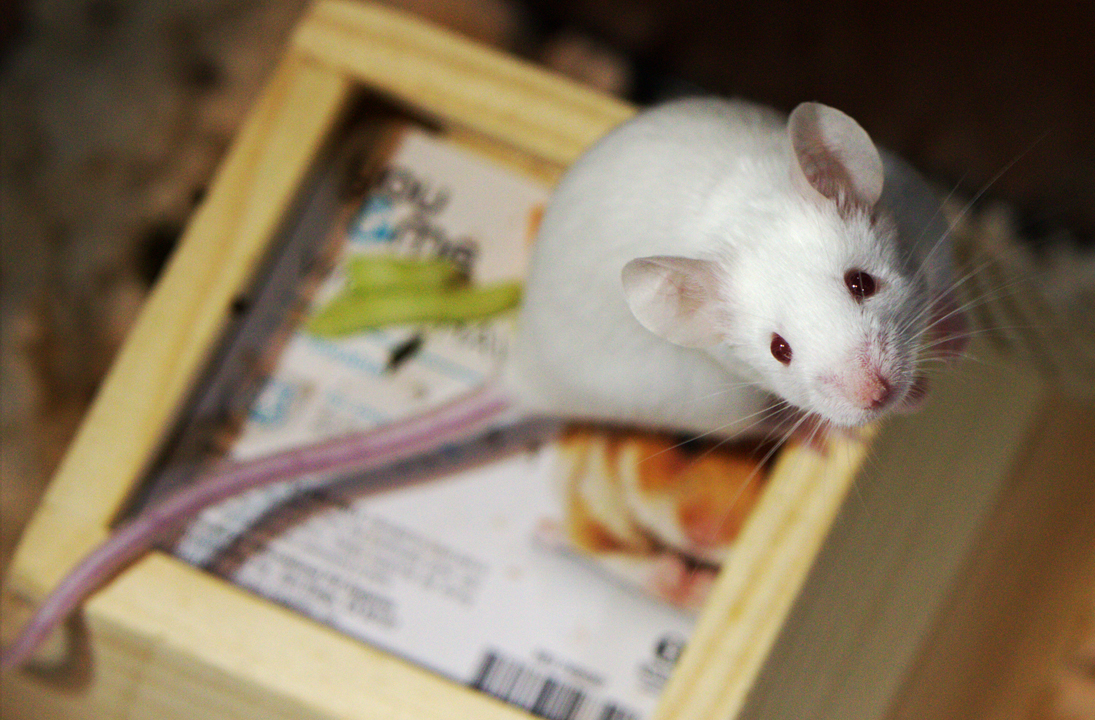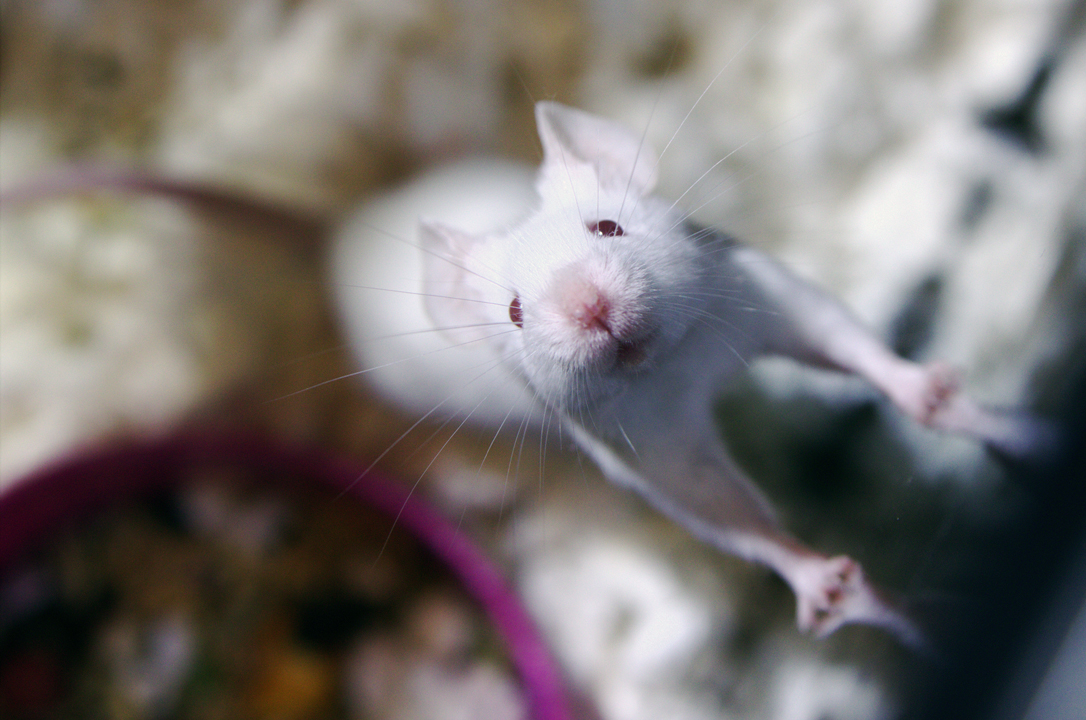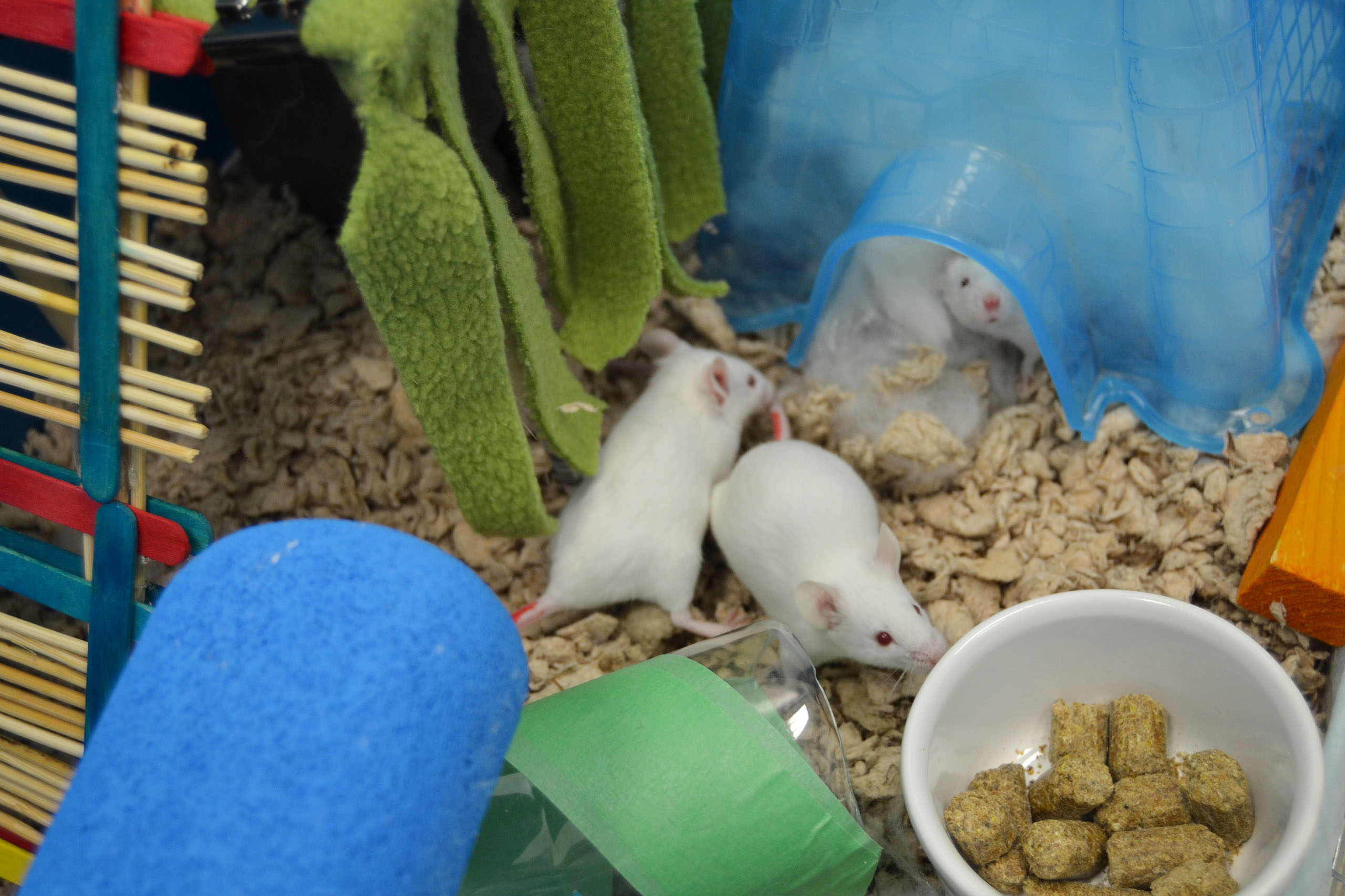
















We are glad that you are interested in opening your home and heart to rescued mice. Mice are incredibly intelligent creatures with a wide array of personalities. While males tend to prefer to live alone unless they have been raised with other males, females are generally more social and prefer to live in groups with other females. Because we respect these natural bonds, female mice are only available for adoption in pairs or groups or to homes that already have one or more females or neutered males.
The cage floor (or levels) themselves, although mostly made out of wire, should NEVER be left as is. Bare wire floors are responsible for feet swelling, redness, sores, ulcerations, bleeding, bumble foot (together with unkempt cage cleaning), and other issues. Because mice spend a good portion of the time when the whole body weight is carried by their hind feet (example- while eating), it is vital to make the cage floor and levels safe for them to use long term! If your cage (or the cage you are yet to get) has bare wire floors, add plastic covers (sometimes available to buy from the same company), cardboard cut to size, or another material that you can easily change up, disinfect and reuse. Or, better yet, get a cage that already comes equipped with plastic covered levels!
Placement of the Cage:
The cage should be placed where the mice will have lots of human contact to make taming easier. It should be out of drafts, away from direct sunlight and out of reach of other household pets.
Bedding:
A deep layer of aspen shavings or some other suitable substrate should be provided in the cage. Avoid cedar and pine shavings due to the strong volatile oils released from these woods (especially cedar). Aspen or other hardwood shavings appear to be a better choice. Another alternative is paper or wood based cat litter - it is very absorbent and good at controlling odors. It is more expensive, but you will likely use less. In addition, some soft nesting material should be provided. Strips of facial tissue or soft paper towel will happily be shredded by mice, and make for a nice nesting material. We don't recommend the commercial cotton bedding material, because some has strands that can get caught on the mice's feet.
Cage enrichment:
Provide small boxes or flower pots to hide in, and cardboard tubes for your mice to chew and run through. You can also add a tree branch for them to climb on. Most mice will enjoy running on an exercise wheel, so be sure to get yours one. Make sure that the wheel has a solid surface without wire rungs, so their tails cannot get caught while running.
Cleaning:
Depending on the size of cage, it may need to be cleaned quite frequently, especially glass or plastic sided cages that allow ammonia and odors to build up more quickly. It is best not to wait until you can smell a problem because it will be quite overwhelming to the mice by then. However, the mice do need to mark their territory and if their cage is completely disinfected too frequently they may be distressed. A good compromise is to leave a bit of the old shavings or litter in the cage at each cleaning (so their scent remains), and only do a thorough scrubbing and disinfecting when absolutely necessary.





Make sure your mouse has clean water available all day, every day. A drip-bottle or two on the side of the cage will work well. Ceramic bowls (such as the ones sold for lizards) are also good, although they can be harder to keep clean.
Mice can be fed a commercially prepared complete diet - a rodent mix or hamster diet is acceptable, either in block or pellet form. Pellets are available for mice and are completely balanced, but this is a monotonous diet. Grain and seed-based loose mixes provide more interest to the mice and will probably be more readily eaten. However, your mice may just pick out their favorite bits and leave the rest, leading to an imbalanced diet. The basic diet can be supplemented with small quantities of fresh fruits and vegetable. Peas, broccoli, carrots, apples and bananas are good foods to start with, but you may need to experiment to find your pets’ favorites. Please don’t overdo it, though—mice have tiny tummies! Watch for diarrhea, and if a particular food item does cause diarrhea, discontinue feeding it. Sunflower seeds are a favorite treat of many mice (but are quite fatty so should be limited), as well as other seeds like millet spray. Cooked pasta and whole grain bread or crackers can also be given. Commercial treat sticks make a good treat but only very occasionally as they are often quite sweet. Do not give your mice cabbage, chocolate, corn, candy, junk food, peanuts, uncooked beans or onions.
Large glass aquariums and wire cages with solid flooring are the best types of cage for mice.
Aquariums *(ten gallon as a starting size!) will need a tight fitting mesh lid and lots of furnishing supplied for climbing and playing. It is also important to remember that ammonia and other fumes will build up faster in an aquarium or plastic sided cage than in a wire cage. However, as long as the lid is tight fitting, they are pretty much escape-proof and have the added advantage of allowing a deep layer of bedding that the mice cannot spread all over your floor.
Wire cages (with horizontal bars) are nice because they provide lots of climbing opportunity on the sides of the cage, and it is easier to fix furnishings, platforms, and toys to the sides of the cage. The most important thing is to make sure the bars are not too narrowly spaced so that the mice can escape (or get stuck trying to escape) and that the doors are placed to allow easy access to the entire cage for when you need to catch the mice. Wire cages marketed for mice are generally quite small, so larger hamster cages or even bird cages are preferable, but ideally the bar spacing should be 1/4 inch. Do not underestimate how small of a space a mouse can squeeze through!
Plastic cages can be made out of large storage bins. If you are handy, or know someone that is, you can cut out parts of the bin, and replace them with firmly attached hardware cloth to provide proper air circulation. Benefits of these DIY cages is that you can stack them on each other, and by attaching flexible tubes, make it possible for mice to navigate from one to another bin having fun in the process, and having much more space available than in a regular cage.
The most important part of training for a companion mouse is getting your new friend accustomed to sitting on your hand. Give the new mouse/mice several days or a week to settle in to their new home before starting to try to touch them. If you need to pick them up before that, use a paper cup.
Once they’ve settled in, lower your hand into the cage, and wait for the mice to come to you. Let them sniff and investigate. Repeat this several times. Eventually, one will probably climb onto your hand. Let her/him sit there and wander off on their own time. After they are done this a couple times, raise your hand a little bit. If the mouse panics, put the hand down again. Once the mouse/mice is comfortable walking on your hand, you can let her/him climb your arms, shoulders, and so on. Remember that she/he can crawl through any hole she can get her/his head through, so be careful about gaps under doorways and bookcases.

















